|
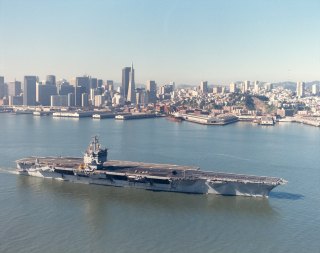
My first aboard ship duty was TDY in the Carrier Intelligence Center
(CVIC) aboard the USS Enterprise (CV-65) when she was based out of NAS
Alameda with Carrier Air Wing 11 embarked in 1987 and 1988. The
Enterprise was our first nuclear-powered carrier, commissioned in 1961.
At 1,101 feet, she remains the longest carrier ever built, though less
displacement than the newer Nimitz class carriers.
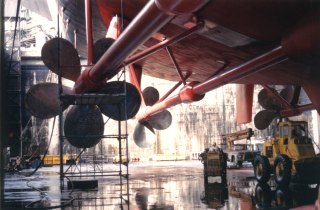
This shows the propulsion end of the Enterprise, revealed in dry dock
at Hunter’s Point. The four five-bladed screws can develop
up to 280,000 shaft horsepower, capable of propelling the ship at speeds
up to 36 knots. Submariners loved to relate the story about how
the Enterprise tried to masquerade as a merchant ship during one exercise,
by only running two of her four screws. The sub’s sonar
operators soon saw through the ruse by evaluating the blade rates, ascertaining
that they were being generated by five-bladed screws! Most merchant
ships use three bladed screws.
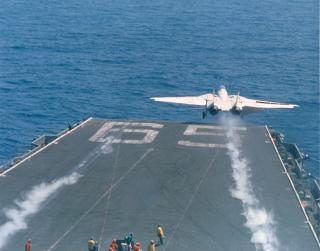
F-14A launching
from Enterprise during flight operations.
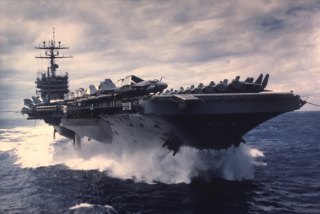
My next aboard ship duty was TDY with the CVIC aboard the USS Carl Vinson
(CV-70) with Carrier Air Wing 15 embarked. This view shows the
Chuckie V motoring at flank speed on her way home from the Gulf of Alaska
after some rough seas caused a parked plane to slide across the deck,
damaging one of the catapult positions. The accident suspended normal
flight operations, so the ship turned up the steam and headed for home
in Alameda. In this view the ship was vibrating like a Mack truck
screaming down Wolf Creek Pass! The navigator stated on the 1MC
that our speed was something “around 34 knots”.
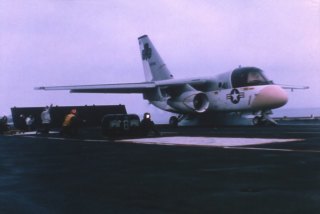
This shows a Lockheed S-3A Viking of Sea Control Squadron VS-41.
I occasionally flew S-3s while TDY on the Enterprise and Vinson.
The VS-29 Dragonfires on the Carl Vinson were my favorite squadron to
fly with.
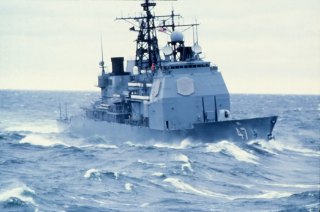
Close up view of the Aegis cruiser USS Ticonderoga (CG-47) in heavy
seas coming in for underway replenishment, part of the weekly routine
of a carrier battle group at sea.
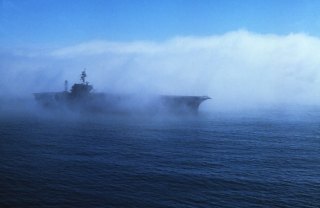
A coastal inversion layer occurs during the warmer summer months when
the cool seawater meets the warm continent along the coast of California.
This view shows the Carl Vinson heading for Alameda through the coastal
fog on a summer morning.
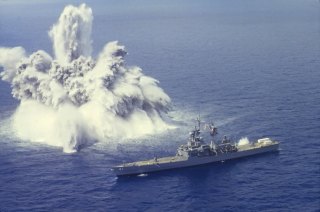
Aerial view of a shock test being carried out against the USS Arkansas
(CGN-41), as photographed by one of our P-3s. The Arkansas is a nuclear
powered Virginia Class cruiser, commissioned in 1980.
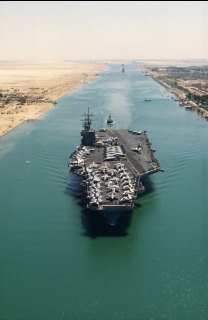
USS Theodore Roosevelt transiting the Suez Canal on its way to the Persian
Gulf in mid-January 1991.
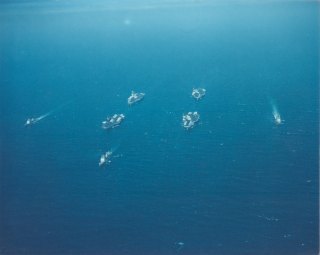
In mid-February 1991 we had four carrier battle groups operating together
in the Persian Gulf, with two others working out of the Red Sea.
This shows the carriers Midway, Ranger, America and Roosevelt steaming
in a “photo formation” for sake of the picture. In
actual operations the carriers would be many miles apart.
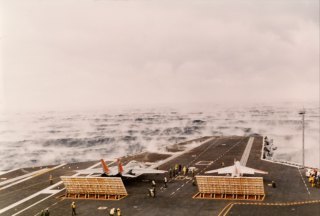
In the fall of 1990 the USS Abraham Lincoln (CVN-72) transited around
the Horn of South America on her way to the Pacific Fleet. This
view shows “sea smoke”, evaporation fog formed when very
cold air drifts over comparatively warm sea water. I developed a dBASE
program for the Lincoln to help them manage classified documents after
they arrived at NAS Alameda.
Questions
or comments on this page?
E-mail Dr. J David Rogers at rogersda@mst.edu.

|